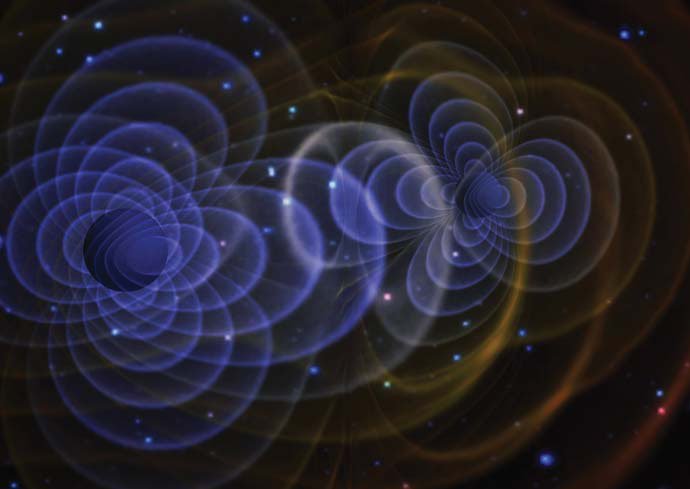Physicists Relish Role in Nobel Prize-Winning Research
Peter Saulson, Duncan Brown, and Stefan Ballmer played a lead role in the analysis of Gravitational wave signals as part of the multinational Laser Interferometer Gravitational-Wave Observatory (LIGO)

Members of the Department of Physics in the College of Arts and Sciences are celebrating their role in the Nobel Prize-winning discovery of gravitational waves.
A team of Syracuse researchers—co-led by Peter Saulson, the Martin Pomeranz ’37 Professor of Physics; Duncan Brown, the Charles Brightman Endowed Professor of Physics; and Stefan Ballmer, Associate Professor of Physics—is part of a multinational organization called the Laser Interferometer Gravitational-Wave Observatory (LIGO).
Earlier today, the Royal Swedish Academy of Sciences awarded the Nobel Prize in Physics to LIGO’s key architects and leaders: Rainer Weiss, a professor at the Massachusetts Institute of Technology; and Barry C. Barish and Kip S. Thorne, professors at the California Institute of Technology.
Using a pair of giant laser detectors, LIGO “heard” gravitational waves, ripples in space and time, coming from the collision of two black holes, 1.3 billion light years from earth. Their existence confirmed Albert Einstein’s general theory of relativity and opened up new windows of exploration of the universe. The discovery was announced in February 2016, following five months of exhaustive analysis, in which Syracuse played a lead role.
Weiss, the co-founder of LIGO, participated in a panel discussion last February at the famed Explorers Club in New York City. There, he was asked to comment on the contributions of the Syracuse group.
“This is a very exceptional group of people. Of all the people in the collaboration, they represent the ideal members you would like to have in a collaboration,” Weiss said.
He added that that the Syracuse team had a big impact on the discovery.
“This group was very influential, the Syracuse group, which has pieces in it that are all parts of the experiment. You’ve got a data analyst and a theorist [Brown], experimenter [Ballmer], who really understands the apparatus, and you’ve got a guy who invented a lot of it, Peter Saulson. These people know what’s in that experiment. I think the fact that they came to the conclusion themselves that this thing was real was damn near important thing to have.”
Brown is a leader in the search for black holes with LIGO. “I am tremendously pleased to see the Nobel committee recognize Rai, Kip and Barry as recipients of the 2017 Nobel Prize in Physics. They are true visionaries, whose leadership has created the new field of gravitational-wave astronomy,” Brown says. “Rai has been a hands-on scientist for as long as I can recall, working on every aspect of LIGO from the lasers and optics to the vacuum systems. Rai is still working on the detectors, making them even more sensitive so they can reach even further into the universe.
“Kip pioneered the dream of using gravitational waves to explore the warped side of the universe. He was confident that black holes would be the first source that LIGO detected and guided generations of scientists through the painstaking research needed to predict what the waves would look like and how to use them to explore the nature of gravity.
“Barry’s leadership helped make LIGO a reality as he guided it from bench-top research projects to the big science of the Hanford and Livingston observatories.”
Brown considers the trio “kind and patient mentors of many generations of scientists,” adding that Barish and Thorne gave him his first job as a physicist at Caltech.
“My appointment was split 50/50 between Kip’s theoretical astrophysics group and the LIGO project under Barry,” Brown continues. “Kip introduced me to ‘numerical relativity,’ the science of predicting the waves black holes emit when they collide. The Caltech LIGO group was a wonderful place to work under Barry, as we laid the experimental foundations for the discoveries that would come years later.”
Ballmer is a member of the Advanced LIGO design team, and helped build the LIGO detectors in Richland, Washington, and Livingston, Louisiana. “LIGO’s mission, at its core, is driven by the curiosity of the human species to explore even the darkest corners of the mysterious cosmos we live in,” Ballmer says. “Today’s recognition by the Nobel committee is confirmation that we as scientists can give back to society, further pushing back the boundary of the known universe. … Being able to contribute to this epic endeavor is truly the greatest honor of my life.”
Saulson, a co-founder of the LIGO Collaboration, discovered how to hang LIGO’s mirrors so they would be quiet enough to detect the tiny ripples in space from gravitational waves. He called the award of the Nobel Prize to Weiss, Barish and Thorne a “triumph” in gravitational physics that has opened up a new world, and is a “brand new way to look at the universe—this is not the last discovery that we will see from LIGO.”
Like many others within the collaboration, Saulson has devoted most of his career to the search for gravitational waves. “We made a wager that decades of work would result in something spectacular,” he says. “This is a remarkably happy moment for us all.”
Featured
Peter Saulson Professor Emeritus
Duncan Brown Vice President for Research, Syracuse University; Charles Brightman Endowed Professor of Physics
Stefan Ballmer Professor
